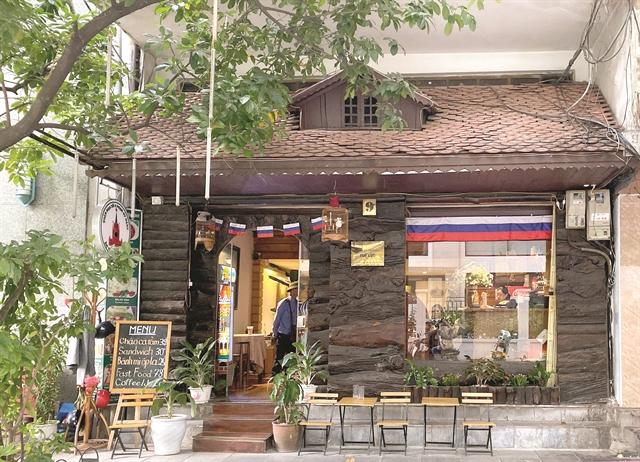
HOMELY: The Russian restaurant has long been a fixture on the little alley in downtown Hà nội, only a few minutes walk from the Hà Nội Opera House. VNS Photo Việt Thanh
by Nguyễn Mỹ Hà
If you go to an expat restaurant in a big city, chances are you'll get some authentic cuisine cooked. This is true about so many Vietnamese restaurants in France and the US.
Such thinking might lead you to assume that the long-standing Russian restaurant in the little alley of Phạm Sư Mạnh Street in Hà Nội was founded by a Russian expat. Wrong! It was set up by a Vietnamese person who went to university in the former Soviet Union.
Another Russian restaurant also resided at this address before and was known as The Little Dream. Now, the new owner simply named it Russian Restaurant.
Back in the 1960s, when Việt Nam was a close ally with the Soviet Union, the Russian language was taught at all public schools throughout the country. It is a beautiful yet very difficult language. Most of the textbooks taught basic conversations, some grammar and lots of vocabulary.
Every year, Việt Nam sent thousands of students to Russia to study all the main sections of government and economy so they would come back and together build up a destroyed country rising from ashes of war.
Later, in the 1980s, more young people also went on government programmes to train as workers in garment factories, steel factories and many more.
After the breakup of the Soviet Union in 1991, many people came back home in Việt Nam, yet they sometimes feel the melancholy of their youth spent in a distant country. They feel the need to eat the food of their youth to quench their nostalgia.
Born under such circumstances, the menu of the Russian Restaurant features most of the popular dishes from the stolovaya, or the college canteen in Russian.
Popular in the chronically underfed country, the food from the stolovaya provided some protein, saturated fat and lots of carbs in potato dishes.
A Russian meal usually comprises of a soup, the first course, the second and dessert.
We opted to have the popular borscht soup (VNĐ35,000). The ruby red colour really warmed us up, like it used to warm up the cold shivering students from Southeast Asia who went halfway around the globe to work or study in Russia.
For the first course, we chose to have two salads: the usual Russian or Olivier salad (VNĐ95,000) and the more sophisticated shuba, or herring under a fur coat (VNĐ138,000).
.jpg)
DELIGHTFUL: Waiting for the long winter to pass with the shuba salad, or herring under fur coat
The salad's name suggests a cold winter, with just one layer of oiled herring mixed with chopped onions under many layers of boiled potatoes, carrots, beetroots mixed with mayonaise, in that exact order, finally topped with a layer of grated boiled egg white and egg yolk.
This is an easy dish to make and some of my friends who studied in Moscow say it's a New Year's dish.
On a typical New Year's Eve, you have the shuba salad for dinner and you watch the iconic Mosfilm movie The Irony of Fate. Though the name may be deceiving, and if you want a happy new year, maybe you'd rather stay away from anything ironic but it's a love story with a happy ending.
For the second dish, we all agreed to order sashlik (VNĐ118,000) to share. The chunks of grilled pork marinated in a mixture of many dried herbs, including a few pinches of saffron, smelled great.

DIG IN: Shashlik, a Russian take on grilled pork. VNS Photos Mỹ Hà
There are two ways of marinating the shashlik, one with central Asian herbs (you can purchase the seasoning packages at Russian food stores) the other with just salt, nothing else. It's debatable which method is more authentic, but the one we had at the restaurant was marinated with mixed herbs, but it only tasted okay as the meat was not juicy enough for us.
Those who did not have shashlik decided to try the kotleti (VNĐ55,000 per ball), served with mashed potatoes. The dish is similar to a cutlet, with a piece of rubbed in dried bread crumbs and deep-fried. The kotleti we had was made into meatballs rolled over bread crumbs, then fried.

WINTER TREAT: A Russian dish named kotleti served with mashed potatoes.
We also ordered some other Russian savoury dishes like a cold cut plate (VNĐ198,000) with salami and pickled cucumber. We ordered a bowl of milk wholewheat porridge (VNĐ39,000) to share.
People around the table recalled the old school canteen joke that students from Việt Nam at Soviet Russian colleges in the 1960s used to be very thin. If they got fed on this porridge, or kasha, then they would become chubby in no time.
For dessert, we chose to have Russian pancakes, or blini (VNĐ58,000) served with smetana.
You may be wondering how was the vodka and caviar, as this is Russian cuisine we're talking about after all?
Well this is not a lavish restaurant catering food of the long-gone Russian empire. You can still order red salmon caviar at (VNĐ298,000) and vodka, but we didn't have it.
It's a cosy place where people who spent some time having Russian food can revisit their youth and go back to a time in their life they cherish. VNS
Nhà hàng Nga, Russian Restaurant
9 Phạm Sư Mạnh St.
Hoàn Kiếm, Hà nội
Tel. 024 2237 2468
Comment: Heart-warming Russian food
OVietnam